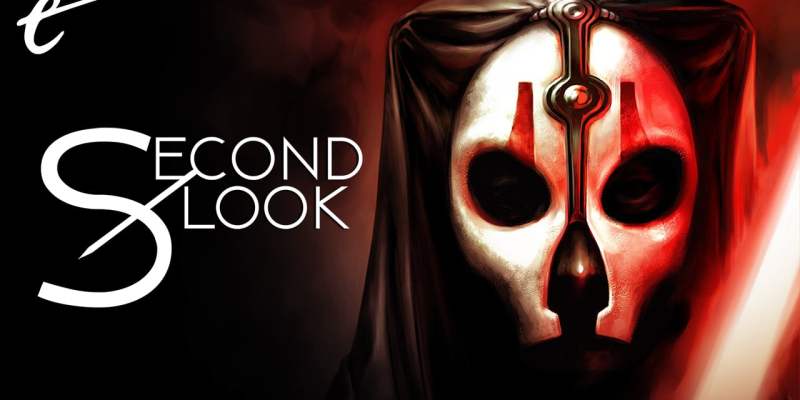Star Wars: Knights of the Old Republic II – The Sith Lords (KOTOR 2), Obsidian’s sole contribution to a galaxy far, far away, remains one of the franchise’s most shining jewels. It’s considered a landmark role-playing experience, expanding leaps and bounds upon the foundation of its predecessor from BioWare.
Yet, when I returned to it this time, after a decade and a canon reset later, I wasn’t met with overwhelming awe. Rather, there was sadness. People always ask me what it is that I “want from Star Wars” if what’s already on offer isn’t enough. Well, what I want is more content with the quality of KOTOR 2.
The combat has aged like spoiled milk, and while I might enjoy the aesthetic, the art design can only do so much to offset the limited animations and blocky graphics. Yet the actual role-playing experience is superb. The prologue aboard the mining facility of Peragus might be a slow burn, but it rewards every character creation choice made.
In lieu of a save state import, it lets you establish the events of the last game in idle conversation, like a gamemaster who improvises without skipping a beat. As tutorials go, few strive as hard to embody the back-and-forth of a player and their GM. This attention to detail extends across the whole campaign.
Rather than archetypes with brief yet exciting backstories and the odd personal quest, your companions are fully realized individuals who embody whole philosophies. They serve not only to critique numerous Star Wars archetypes, but to play off each other to explore deeper themes.

The Sith assassin Visas is contemplative and patient, with even her romantic arc fitting more of an asexual dynamic than a carnal one. When you view the world in first-person through her gaze, you experience the galaxy as seen through the Force itself. Yet it’s her own hesitance that led her to being forced into servitude under one of the most terrifying Sith Lords who ever lived.
By contrast, the heroic Handmaiden is purely about the physical, processing everything through actions, immediacy, and sensation. To get to know her, you have to duel, with her character sheet having built her to easily beat you in hand-to-hand combat. Her lack of knowledge in all but fighting isn’t simply a class restriction, but a fundamental character flaw from years of repression by her teacher.
Neither character is presented as superior, with their fight in the restored climax demonstrating that they merely come from two different perspectives that need to reconcile. They need to act, but not rashly. They can’t stand idly, but caution is necessary when defeating the final Sith Lord. The ideal outcome is that they find temperance, yet death follows if they’ve been misguided by your decisions.
More than the characters, the very foundations of how CRPGs work are embraced in KOTOR 2. Even leveling up is explained as a result of a parasitic wound you’ve acquired from surviving the Mandalorian Wars. Earning loyalty among your crew is your protagonist building actual Force bonds with each of them.

Cliche choices are skewered and recontextualized through the framing device of Force-based morality. This isn’t simply to mock the arguably problematic binary, but to make players think about why we so often embrace convenient falsehoods and platitudes over the more complex reality at hand. Yet it’s done so casually, introduced over time through each element, that even the young kids playing it at the time could understand.
Much has been said about your mentor Kreia, the heretical Force mystic who accompanies you on your journey. Yet she’s but one mouthpiece amid myriad pointed explorations of what you can say about the westernized dualist philosophy at the heart of Star Wars.
Genre, medium, and subject matter are all fully embraced by Obsidian as tools rather than restrictions. Though there are connections and nods to the great saga, KOTOR 2 doesn’t lose itself by bending over backwards to force these moments. Instead, Obsidian factors it all in organically, drawing heavily on what’s relevant to the story first and foremost.
This is the sort of Star Wars media that kept the franchise blooming between the films. It’s equal parts loving and scathing, willing to push the envelope and really treat Star Wars as an explorable universe with internal rules and logic. It doesn’t just look or sound like Star Wars – KOTOR 2 is completely ensconced in it all. The game uses every aspect of itself to further focus and refine its themes and messages, not just to sell an adjacent product.
And I really miss that, because Star Wars doesn’t do that anymore.

I’m not saying the new timeline is joyless or without some stories that put in effort, but these are sparse exceptions across a glut of otherwise insubstantial content. The reason people put up with the odd Kevin J. Anderson fluff or a pixelated computer game was for the universe. Fans cared because it felt alive and tangible, especially in the likes of KOTOR 2. Now, Star Wars is often little more than a brand.
Every time we’ve been promised something bold or cohesive to help nurture the setting, it’s fallen flat. Star Wars Jedi: Fallen Order, Battlefront II, and The High Republic have largely feigned depth while merely blustering on about aspects that don’t connect organically. There’s a difference between an intertwined universe and jamming in a few cameos and references here or there. It all tries to feel like the “good ol’ days,” but it’s about fitting a specific form rather than understanding the mechanisms underneath.
The heart of what made so many nerds care about Star Wars wasn’t CGI actors or “mega stories” – it was a fictional setting that feels alive the second you tap into it. You realize that, for as epic as Luke’s journey may have been, his was only one of thousands. It’s the sort of world where you can see yourself becoming the hero because anyone can. So few settings can match the depth, complexity, and creativity of what once existed. That’s a lot more impressive than an advertisement for an overpriced hotel.
